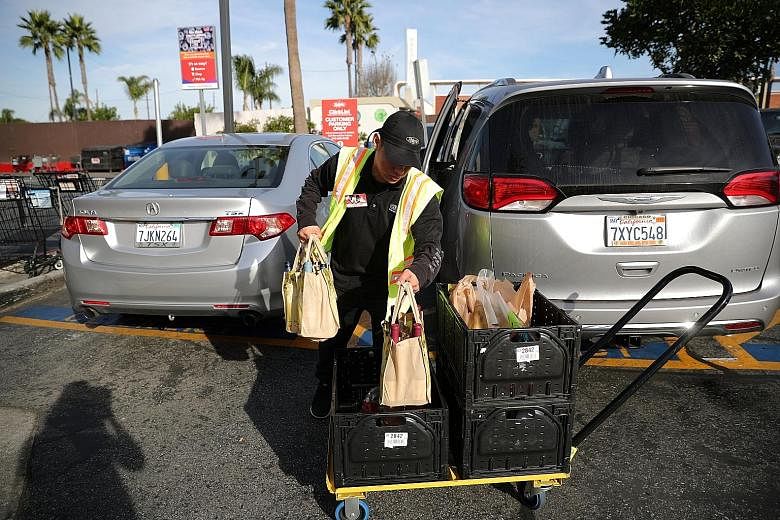LOS ANGELES • As Amazon.com looks to upend the US grocery market with home delivery, some veteran supermarket operators are betting on a different strategy: kerbside pickup.
Americans have long loved the convenience of drive-through service for burgers and coffee. Kroger and Wal-Mart are tweaking that formula for groceries. The companies have invested heavily in online systems that allow customers to order ahead from their neighbourhood store. Workers pick and pack the products, then run these out to shoppers in the carpark - the grocery version of takeaway pizza.
For the retailers, the service is cheaper than delivery, because customers do the driving. For shoppers, it means skipping crowds and queues at their local market, and no worries about missing packages or melted ice cream if they are not at home to meet the delivery guy.
Los Angeles resident Tony Sacco is a regular user of the service at a nearby Ralphs supermarket, owned by Cincinnati-based Kroger. Each pickup costs US$6.95 (S$9.40) but the time-crunched father of three says it is worth it.
"This is easy. Time is money," Mr Sacco said as a worker loaded bags into his car on a recent morning.
Retaining customers like Mr Sacco, 47, is critical for traditional grocery retailers as they battle an array of upstarts like organic food seller Thrive Market bent on turning groceries into the next home-delivery juggernaut.
Amazon, the nation's largest online retailer, has amassed an 18 per cent share of the US$12.6 billion online grocery market in the United States. It is the largest player in a sector that is expected to grow to US$41.7 billion by 2022, said market research firm Packaged Facts.
But even mighty Amazon has struggled with the trickiest part of the trade: delivering fresh produce, meat, dairy and other perishables. Its AmazonFresh service started more than a decade ago, but has yet to make a major mark.
Amazon is making another run at it with its US$13.7 billion purchase of upscale grocery chain Whole Foods earlier this year. Analysts expect it will use Whole Foods' 450 locations as distribution hubs for home delivery, opening a new front in its campaign to disrupt the US$700 billion US grocery industry.
Traditional players are responding with some new moves of their own. Kroger and Wal-Mart are experimenting with delivery, but they are wagering that pickup is the true sweet spot in the industry's online evolution. Both are rolling out the service in thousands of their stores.
"The way people are going to shop for groceries is going to be kerbside, not delivery," said Mr Jason Goldberg, a senior vice-president at digital marketing firm SapientRazorfish.
Packaged Facts said traditional retailers can win with real estate. "Companies such as Wal-Mart and Kroger have the advantage, because they already have stores all over the country," it said in a recent report.
Kroger bought its way into pickup with its 2014 purchase of grocer Harris Teeter, which had an established programme. That same year, Kroger debuted its own offering, ClickList.
Mr Matt Thompson, the vice-president of ClickList, said kerbside customers spend 40 per cent to 60 per cent more than regular shoppers because they tend to stock up on bulky items such as bottled water.
Users pay US$4.95 to US$6.95 for each order depending on their location. They log in to ClickList. They put items into digital carts, pay and reserve a pickup time at least four hours in advance. When they pull into designated pickup parking spaces, they are directed to call a number to alert a ClickList worker, who wheels the bags to their cars.
Virtually every food retailer is now testing or adding pickup, including Publix and Safeway.
"That's why you want to be early, so you can capture someone else's customers," said Loop Capital analyst Andrew Wolf.
REUTERS

